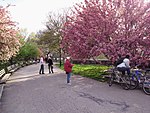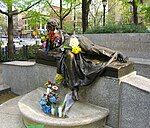The Manhasset is a residential building on the western side of Broadway, between 108th and 109th streets, on the Upper West Side of Manhattan in New York City, United States. Constructed between 1899 and 1905 as one of several apartment hotels along Broadway on the Upper West Side, the Manhasset was designed in the Beaux-Arts style and was split into northern and southern halves. The lowest eight stories of the 11-story building were designed by Joseph Wolf, while the top three stories were designed by the firm of Janes & Leo. The building is a New York City designated landmark.
The base is two stories high and is clad with rusticated limestone blocks; it has entrances on 108th and 109th streets, as well as storefronts on Broadway. The central section of the facade is largely made of salmon brick, with ornamentation made of architectural terracotta. There are exterior light courts facing north, south, and west. The structure is topped by a two-story mansard roof. As built, the Manhasset had 77 apartments spread across the northern and southern sections; following a 1939 renovation, the building has had 136 apartments.
The Manhasset was developed by John W. and William Noble, who acquired the site in 1899 but were unable to complete the structure. Although the Manhasset was built as an eight-story edifice, Jacob Butler expanded it to 11 stories after taking over the development in 1901. The building was finished in 1905, and the Butler family retained it until 1909. Storefronts were added to the ground floor in 1910, and the Manhasset was sold several more times over the years. The Mutual Life Insurance Company, which acquired the Manhasset in 1932, subdivided the apartments between 1939 and 1940. The Heller family acquired the Manhasset during the late 20th century and converted the apartments into a housing cooperative in 1993, retaining ownership of the retail condominium at the building's base. After undergoing a renovation in the late 1990s, the Manhasset was damaged by a fire in 1999.









